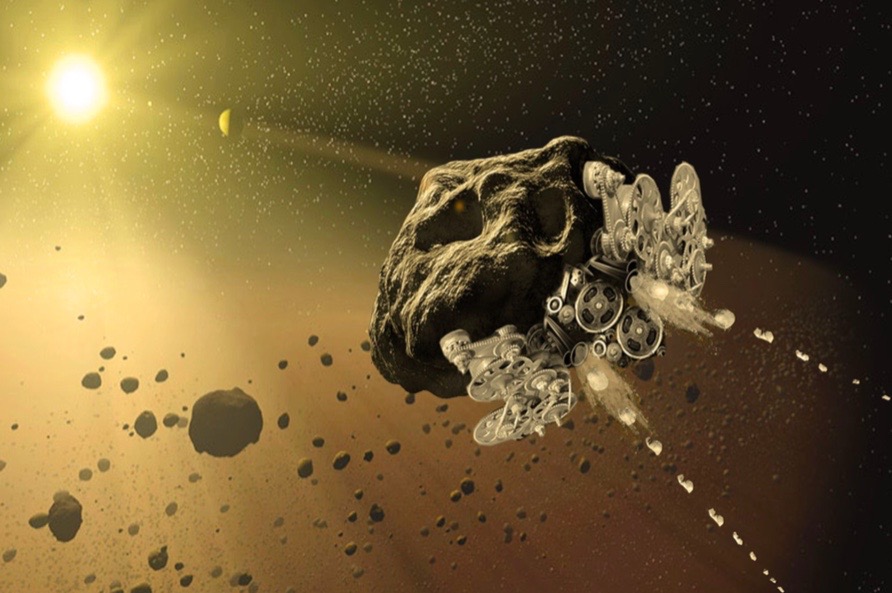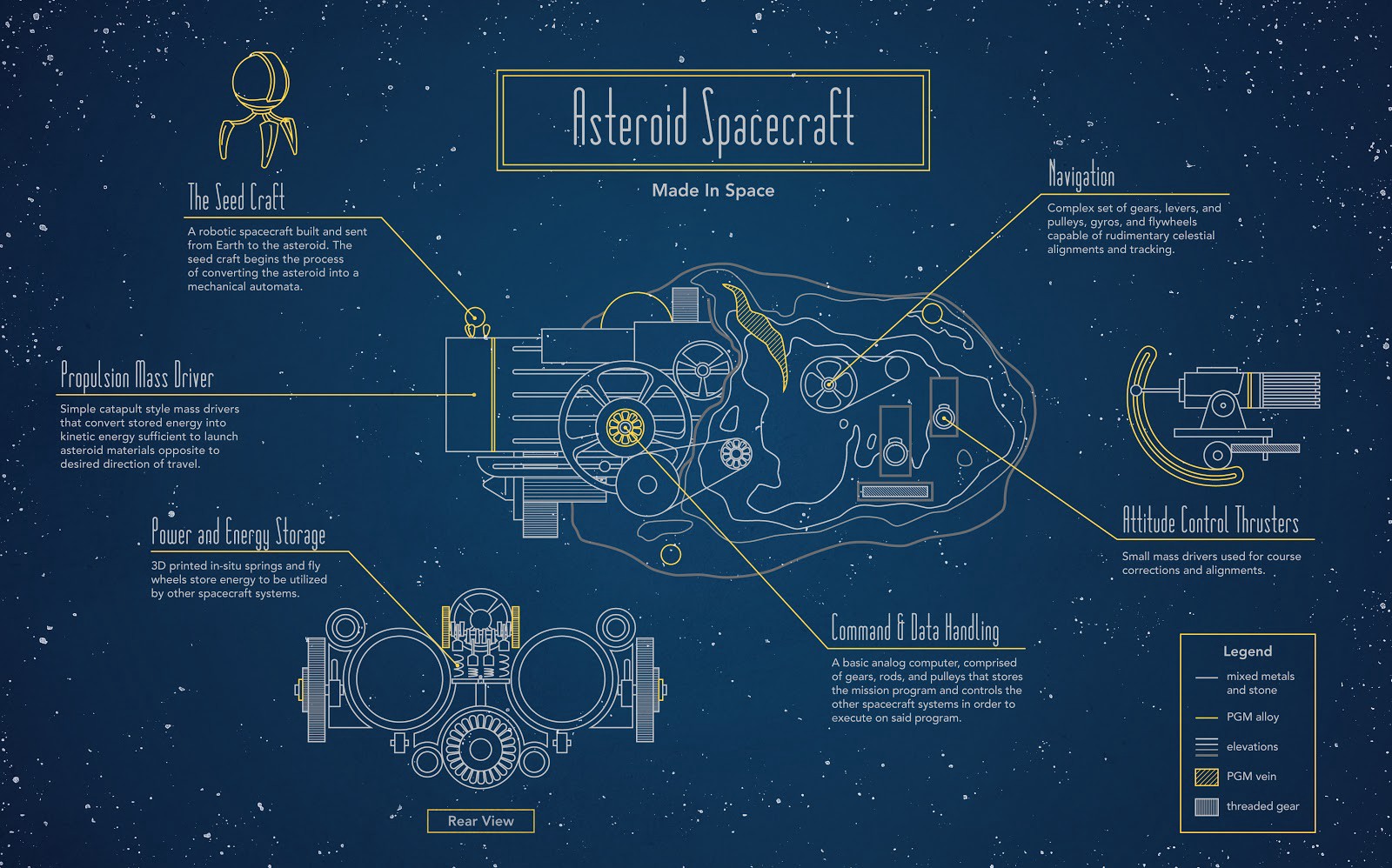
A few decades from now, asteroids may be flying themselves to mining outposts in space, nobly sacrificing their abundant resources to help open the final frontier to humanity.
That's the vision of California-based company Made In Space, which was recently awarded NASA funding to investigate how to turn asteroids into giant, autonomous spacecraft.
The project, known as RAMA (Reconstituting Asteroids into Mechanical Automata), is part of Made In Space's long-term plan to enable space colonization by helping make off-Earth manufacturing efficient and economically viable. [How Asteroid Mining Could Work (Infographic)]
"Today, we have the ability to bring resources from Earth," Made In Space co-founder and chief technology officer Jason Dunn told Space.com. "But when we get to a tipping point where we need the resources in space, then the question becomes, 'Where do they come from and how do we get them, and how do we deliver them to the location that we need?' This is a way to do it."

The plan
Made In Space's idea involves sending an advanced, robotic "Seed Craft" out to rendezvous with a succession of near-Earth asteroids in space.
The Seed Craft would harvest material from the space rocks, then use this feedstock to construct propulsion, navigation, energy-storage and other key systems onsite with the aid of 3D printing and other technologies. (Made In Space has considerable 3D-printing expertise; the company built the two 3D printers that were installed aboard the International Space Station in the past year and a half.)
Get the Space.com Newsletter
Breaking space news, the latest updates on rocket launches, skywatching events and more!
Thus transformed into autonomous spacecraft, the asteroids could be programmed to fly to a mining station in Earth-moon space, or anywhere else they were needed. This approach would be much more efficient than launching a new capture probe (or probes) to every single space rock targeted for resource exploitation, Made In Space representatives said.
The converted asteroids wouldn't resemble the traditional idea of spacecraft, with rocket engines and complex electronic circuitry. Rather, everything would be mechanical and relatively primitive.
For example, the computer would be analog, akin, perhaps, to the Antikythera mechanism invented by the ancient Greeks to chart the motion of heavenly bodies, Dunn said. And the propulsion system might be some sort of catapult that launches boulders or other material off the asteroid in a controlled way, thereby pushing the space rock in the opposite direction (as described by Newton's Third Law of Motion), he added.
"At the end of the day, the thing that we want the asteroid to be is technology that has existed for a long time. The question is, 'Can we convert an asteroid into that technology at some point in the future?'" Dunn said. "We think the answer is yes."
Project RAMA is not starting from scratch. Autonomous 3D printers that use mechanically driven systems already exist, Dunn noted, as do mechanical computers made of 3D-printed parts.
Still, making it happen will require significant advances in a number of areas, including in-situ resource utilization (ISRU) — the art of living off the land. Made In Space is counting on NASA to push ISRU technology forward, Dunn said. (Advanced ISRU tech will be vital for supporting astronauts on Mars and other off-Earth outposts, NASA officials have said.) [What Technology Will Humans Need to Explore Mars? (Video)]

Early days yet
Made In Space's larger vision won't be realized for a while, because RAMA is still in the very early stages.
In April, the project received a Phase 1 grant from the NASA Innovative Advanced Concepts (NIAC) program, which aims to encourage the development of potentially revolutionary space-exploration technologies.
Phase 1 NIAC awardees get $100,000 for nine months' worth of initial feasibility studies. (Recipients can then apply for a Phase 2 NIAC award, which is worth about $500,000 and funds two years of further concept development.)
Any discussion of Project RAMA timelines is therefore incredibly speculative, Dunn stressed. Still, he estimated that the effort might require 20 years or so of technology development and other work. If that's the case, the first Seed Craft may get off the ground in the late 2030s — perhaps just as asteroid-mining and off-Earth manufacturing are coming into their own.
"The anticipation is that the RAMA architecture is a long time line, and when it becomes capable is about the same time that people really need the resources," Dunn said.
Project RAMA could also have applications here on Earth, he added, saying that machines similar to Seed Craft could do a variety of jobs around the planet.
"You could build infrastructure in remote locations somewhat autonomously, and convert resources into useful devices and mechanical machines," Dunn said. "This actually could solve some pretty big problems on Earth, from housing to construction of things that make people's lives better."
You can read more about Project RAMA at Made In Space's NIAC page and in a piece that Dunn wrote for Medium.com.
Follow Mike Wall on Twitter @michaeldwall and Google+. Follow us @Spacedotcom, Facebook or Google+. Originally published on Space.com.
Join our Space Forums to keep talking space on the latest missions, night sky and more! And if you have a news tip, correction or comment, let us know at: community@space.com.

Michael Wall is a Senior Space Writer with Space.com and joined the team in 2010. He primarily covers exoplanets, spaceflight and military space, but has been known to dabble in the space art beat. His book about the search for alien life, "Out There," was published on Nov. 13, 2018. Before becoming a science writer, Michael worked as a herpetologist and wildlife biologist. He has a Ph.D. in evolutionary biology from the University of Sydney, Australia, a bachelor's degree from the University of Arizona, and a graduate certificate in science writing from the University of California, Santa Cruz. To find out what his latest project is, you can follow Michael on Twitter.









